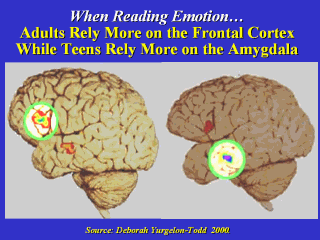Search inside of Supercourse and lectures in HTML and PPT format
 |
 |
front |1 |2 |3 |4 |5 |6 |7 |8 |9 |10 |11 |12 |13 |14 |15 |16 |17 |18 |19 |20 |21 |22 |23 |24 |25 |26 |27 |28 |29 |30 |31 |32 |33 |34 |35 |36 |37 |38 |39 |40 |review |
 Adolescents’ brains are “wired” differently than adults. Because the prefrontal cortex is one of the last areas of the brain to mature during development, adolescents tend to use other areas – in this case emotional areas – of the brain in making decisions. For example, brain activity, seen with functional MRI, shows that when judging emotion represented on a face, a teenager’s amygdala (right) is activated, reflecting more of a gut reaction than a reasoned one, while the adult’s (left) brain is activated in an area of the prefrontal cortex involved more in reasoning and reflection. |